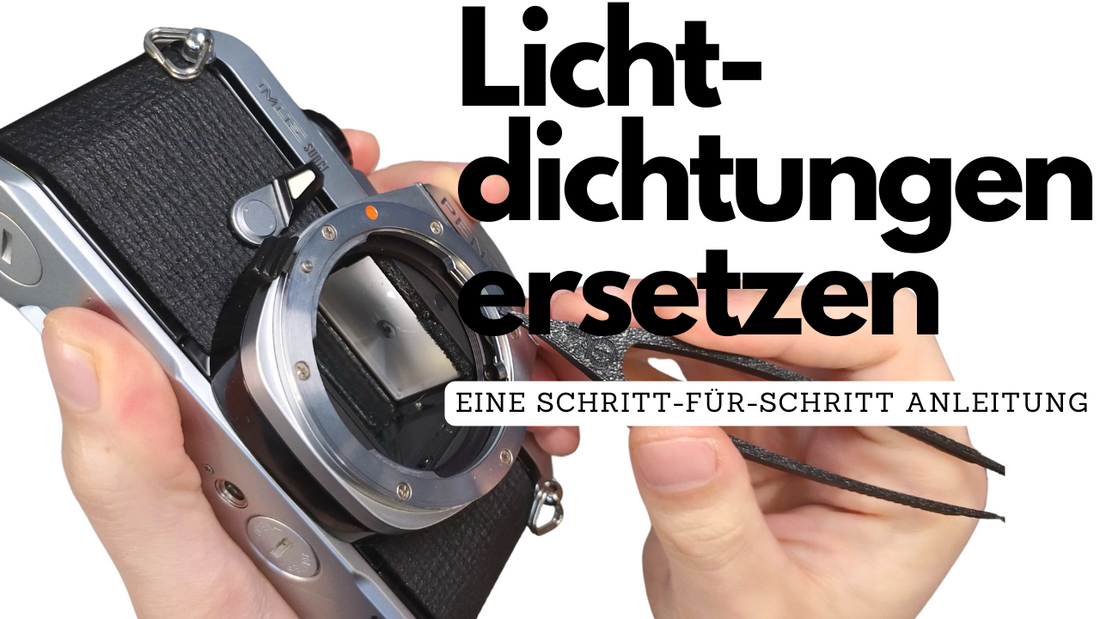
How to replace the light seals of your analog camera
Share
The following video (in English, with German subtitles) shows the process in detail:
If you own one or more analogue cameras, then the chances are high that the light seals on one or all of them need to be replaced.
These small foam strips break down over time and can cause light leaks that, in the worst case, can completely ruin your photos. In any case, the image quality suffers, and unfortunately, over 90% of all cameras available on the market (even from dealers!) are sold with defective light seals.
If the seller doesn't explicitly state it, you can assume that a camera is being sold with defective light seals.

Photo: So-called light leaks or "light leaks" caused by defective light seals
The replacement requires some time, patience, and nerves, but it can also be done well by beginners on a quiet afternoon. In this guide, I'll show you step by step how to replace the light seals – just like we used to do in our small camera workshop. We've sealed hundreds, if not thousands, of cameras this way, and it has always worked reliably.
What you need
- Pre-made light seal set or foam mats in various thicknesses for cutting
- Usually you need a 1 mm thick mat for the seals on the back cover
- and a 2 mm thick mat for the mirror stop damper
- Carpet knife, ruler, and cutting mat (for self-cutters)
- Cotton swabs
- Isopropyl alcohol (to remove the old seals)
- Small flathead screwdriver to scrape off the old seals
- Tweezers for precise positioning of the new seals
- Painter's tape (to protect the shutter during cleaning)
- Microfiber cloth and toothbrush (for final cleaning)
In our ready-made light seal set you get everything you need for the replacement except the solvent (isopropanol), including special tweezers with an integrated scraper for stubborn seal residues.

Photo: Contents of our light seal set from Ausgeknipst with pre-cut light seals in various thicknesses and widths, cotton swabs, cold shoe cover (available as a bonus in Feb 2025) & special tweezers.
Which cameras is this guide suitable for?
The process is almost identical for most 35mm SLRs, e.g. Canon AE-1, Olympus OM-1, Pentax ME, or Minolta SRT series.
Step 1: Remove the old light seals
You can usually find the old seals:
- At the upper and lower edge of the back door

- Around the hinge of the back door

- At the mirror stop damper (not real sealing material, but should be replaced often)

How to remove the old seals:
1. Apply isopropyl alcohol to the old seals with a cotton swab.

Photo: Old seals can be dissolved with some isopropanol and then removed more easily.
2. Wait a moment for the material to soften, then carefully scrape it out with tweezers or a small screwdriver.

Photo: You can carefully scrape off the old seals with the back part of our tweezers. Don't apply too much pressure, or you might damage your camera's paint.
3. Make sure no residues fall inside the camera.

Photo: If old sealing material falls inside the camera, you can hold the camera with the opening facing down and gently blow air in with a blower. Sometimes tapping a little from behind the camera helps too. Be careful: like with a baby who is choking ;)
4. Finally, remove the last particles with a cotton swab soaked in isopropanol

Photo: To remove the last remnants of the old light seals, you can tear off a piece of cotton from a cotton swab with your fingers, clamp it in tweezers, and dip it in isopropanol. Then run the soaked cotton ball along the sealing groove until the cotton stays completely white. The more thorough you are here, the better the new seals will adhere later.

Photo: Removing the brittle mirror stop damper on a Pentax ME Super
Tip: Be especially careful when removing the upper and lower door seals. No alcohol should get into the shutter mechanism of the back door (usually top right), as it could damage the mechanism.

Photo: Most cameras have a small opening here for the automatic reset of the film counter. No old sealing material should get in here, as it can block the mechanism.
Step 2: Install the new light seals
After cleaning, you can install the new seals:
- If you use foam sheets, cut the strips exactly to the required size.
- For pre-made adhesive seals, remove the protective film and carefully fit the strips into the grooves.
- Press the strips into the correct position using tweezers.
- Make sure the seal fits well at the hinge and the door still closes easily.

Photo: New light seals are best positioned precisely with tweezers.
The trickiest part is the thin seals along the back door grooves. If they twist, just stay calm and press them into the groove with tweezers. These self-adhesive strips are a bit fiddly to position but you don’t need to buy special glue.
Step 3: Replace the mirror stop damper
- Find the old mirror stop damper (usually a foam strip above the mirror).
- Remove it carefully so no particles fall into the mirror box.
- Cut the new damper to the appropriate size.
- Use tweezers to place it exactly in the right spot.

Photo: Inserting the new mirror stop damper
Important: Do not get alcohol on the focusing screen! It can be permanently damaged.
Step 4: Final cleaning and inspection
- Remove any remaining dust with a toothbrush and a microfiber cloth.
- Remove the painter's tape from the shutter.
- Close the back door and check if all seals are seated properly.
Photo: Finally, clean your camera with some dish soap water, a toothbrush, and a microfiber cloth.
Conclusion
Done! Your camera now has new light seals and should work perfectly again – goodbye light leaks!
This guide is designed for 35mm SLRs but can also be applied to medium format cameras or film cassettes with small adjustments.
If you have any questions, feel free to leave me a comment or send us a message via the contact form in our online shop :) I'm looking forward to photos of freshly sealed cameras!
Have fun taking photos and best regards, your Vladi! 🎞📸



2 comments
Hallo ich habe mir das Set gekauft, bin aber mächtig enttäuscht. Die dünnen Dichtungen an der Rücktür sind einfach nicht montierbar mit der selbstklebenden Rückseite. Bezeichnenderweise gibt es nur ein YouTube Video, bei dem die Rückseite nicht selbstklebend ist. Es ist für Normalsterbliche nicht möglich, den Streifen so hinzukriegen, dass er perfekt in der schmalen, tiefen Rille sitzt ohne dass auf einer Seite etwas Klebstoff herausschaut. Beim Festdrücken des Streifens erwischt dann die Pinzette etwas Klebstoff und das Festdrücken wird zum Fiasko. Auch wird nicht vorgeschlagen, ob die Schutzfolie komplett abgezogen werden sollte (dann muss man höllisch aufpassen, dass der dünne Streifen nirgendwo hängenbleibt) oder ob man die Schutzfolie etappenweise entfernen sollte ( dann bräuchte man eine dritte Hand). Insgesamt sehr unausgegoren. Man hätte das Produkt mit ungeübten Leuten testen sollen.
Ich habe jetzt den Streifen mitsamt der Schutzfolie in die Rille gebracht. Hält einfach durch Reibung und erzeugt keine klebrigen Stellen.
Hi, gutes Video zum Austausch der Lichtdichtungen. Vorteilhaft bei meinen Kameras war zum Tausch der Spiegeldämpfer den Innenraum gegen Krümmel mit den gelben zugeschnittenen Post-It zu verschließen, so kam nie ein schmieriger Krümmel auf den Spiegel oder die Mattscheibe.